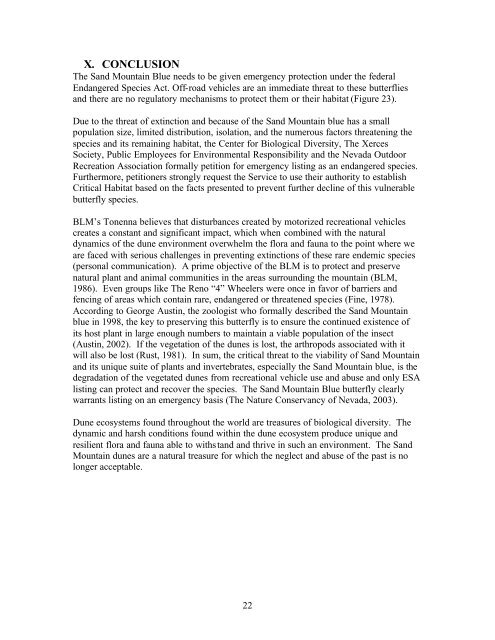Sand Mountain blue butterfly - The Xerces Society
Sand Mountain blue butterfly - The Xerces Society
Sand Mountain blue butterfly - The Xerces Society
Create successful ePaper yourself
Turn your PDF publications into a flip-book with our unique Google optimized e-Paper software.
X. CONCLUSION<br />
<strong>The</strong> <strong>Sand</strong> <strong>Mountain</strong> Blue needs to be given emergency protection under the federal<br />
Endangered Species Act. Off-road vehicles are an immediate threat to these butterflies<br />
and there are no regulatory mechanisms to protect them or their habitat (Figure 23).<br />
Due to the threat of extinction and because of the <strong>Sand</strong> <strong>Mountain</strong> <strong>blue</strong> has a small<br />
population size, limited distribution, isolation, and the numerous factors threatening the<br />
species and its remaining habitat, the Center for Biological Diversity, <strong>The</strong> <strong>Xerces</strong><br />
<strong>Society</strong>, Public Employees for Environmental Responsibility and the Nevada Outdoor<br />
Recreation Association formally petition for emergency listing as an endangered species.<br />
Furthermore, petitioners strongly request the Service to use their authority to establish<br />
Critical Habitat based on the facts presented to prevent further decline of this vulnerable<br />
<strong>butterfly</strong> species.<br />
BLM’s Tonenna believes that disturbances created by motorized recreational vehicles<br />
creates a constant and significant impact, which when combined with the natural<br />
dynamics of the dune environment overwhelm the flora and fauna to the point where we<br />
are faced with serious challenges in preventing extinctions of these rare endemic species<br />
(personal communication). A prime objective of the BLM is to protect and preserve<br />
natural plant and animal communities in the areas surrounding the mountain (BLM,<br />
1986). Even groups like <strong>The</strong> Reno “4” Wheelers were once in favor of barriers and<br />
fencing of areas which contain rare, endangered or threatened species (Fine, 1978).<br />
According to George Austin, the zoologist who formally described the <strong>Sand</strong> <strong>Mountain</strong><br />
<strong>blue</strong> in 1998, the key to preserving this <strong>butterfly</strong> is to ensure the continued existence of<br />
its host plant in large enough numbers to maintain a viable population of the insect<br />
(Austin, 2002). If the vegetation of the dunes is lost, the arthropods associated with it<br />
will also be lost (Rust, 1981). In sum, the critical threat to the viability of <strong>Sand</strong> <strong>Mountain</strong><br />
and its unique suite of plants and invertebrates, especially the <strong>Sand</strong> <strong>Mountain</strong> <strong>blue</strong>, is the<br />
degradation of the vegetated dunes from recreational vehicle use and abuse and only ESA<br />
listing can protect and recover the species. <strong>The</strong> <strong>Sand</strong> <strong>Mountain</strong> Blue <strong>butterfly</strong> clearly<br />
warrants listing on an emergency basis (<strong>The</strong> Nature Conservancy of Nevada, 2003).<br />
Dune ecosystems found throughout the world are treasures of biological diversity. <strong>The</strong><br />
dynamic and harsh conditions found within the dune ecosystem produce unique and<br />
resilient flora and fauna able to withstand and thrive in such an environment. <strong>The</strong> <strong>Sand</strong><br />
<strong>Mountain</strong> dunes are a natural treasure for which the neglect and abuse of the past is no<br />
longer acceptable.<br />
22
















